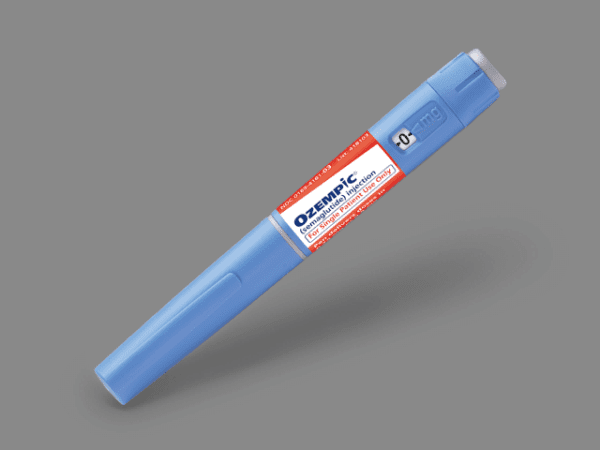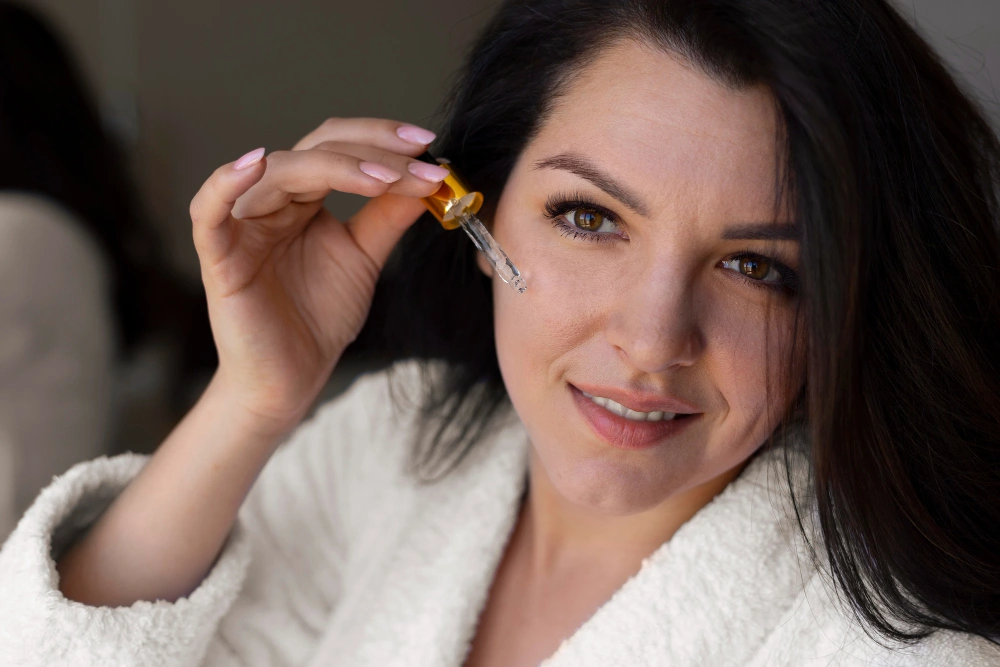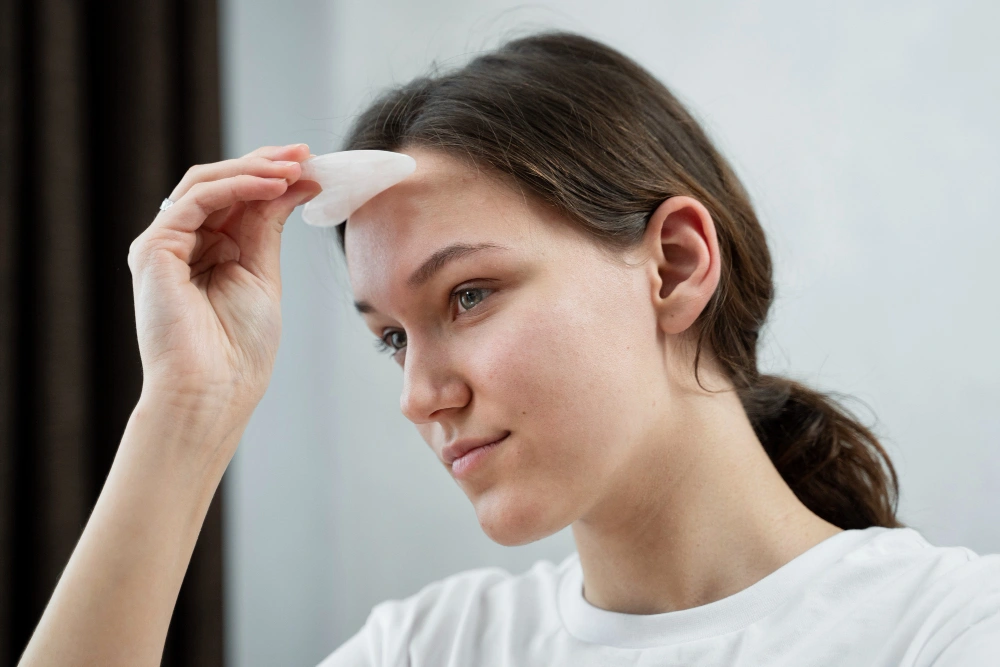Tretinoin forehead wrinkles before and after
Transform your mental health journey with our top practitioners. Speak with a provider today to see what treatment is right for you.
- Appointments any day of the week
- Licensed healthcare providers in your state
- 24/7 patient support
Forehead wrinkles can be a telltale sign of aging. They can appear due to various factors, including repetitive facial expressions, sun exposure, and natural aging. But what if there was a way to reduce their appearance? Enter tretinoin. This powerful derivative of Vitamin A has been making waves in the skincare world. It’s not just for acne anymore.
Tretinoin has shown significant anti-wrinkle properties. It works by increasing cell turnover and stimulating collagen production. This can lead to a noticeable reduction in forehead wrinkles. But how effective is it really? This article will delve into the world of tretinoin and its impact on forehead wrinkles. We’ll explore real-life before and after stories, backed by scientific research.
We’ll also guide you on how to use tretinoin for anti-aging purposes. From choosing the right strength to managing potential side effects, we’ve got you covered. So, if you’re considering tretinoin for your forehead wrinkles, or if you’re already using it and want to learn more, keep reading. This comprehensive guide is for you.
Receive a personalized treatment plan from a medical provider after an online mental health assessment.
Understanding Tretinoin and Its Anti-Aging Properties
Tretinoin, a derivative of Vitamin A, is a potent ingredient with multiple skin benefits. Its role extends beyond acne treatment, having strong anti-aging credentials. By increasing cell turnover, tretinoin helps shed old skin layers. This process makes way for fresh, new skin to emerge.
Enhanced skin texture is another advantage. Users often notice smoother and more evenly toned skin with consistent tretinoin use. This rejuvenation is why tretinoin remains popular in anti-aging skincare.
It also increases collagen production, a crucial protein for youthful skin. Collagen provides structure and elasticity, which are important for wrinkle-free skin.
But tretinoin is not a quick fix. Results require patience and dedication. Many users see results after several weeks or months of consistent application. Sun protection and proper skincare routines enhance its effectiveness.
Balancing tretinoin’s potent action with skin care is key. Moisturizers can help minimize dryness and irritation. Understanding how tretinoin works can empower users to maximize its benefits safely.
Ultimately, tretinoin stands out for its multi-faceted anti-aging properties. Used correctly, it offers promising solutions for those targeting forehead wrinkles and other signs of aging.
What is Tretinoin?
Tretinoin is a topical medication derived from Vitamin A. It is also known as retinoic acid. Available by prescription, it is effective against acne and signs of aging.
Unlike over-the-counter retinoids, tretinoin’s potency delivers faster, more noticeable results. It accelerates the skin’s renewal process, fostering a fresher complexion.
Applied consistently, tretinoin acts at a cellular level. It instructs skin cells to regenerate at a quicker pace, enhancing overall skin health. This makes tretinoin a staple for those seeking comprehensive skincare solutions.
How Does Tretinoin Combat Forehead Wrinkles?
Tretinoin’s efficacy against forehead wrinkles is due to its multi-level action. First, it boosts cell turnover, reducing dead skin buildup. This renewal reveals smoother, more youthful skin.
Moreover, tretinoin contributes to the fading of fine lines. Its exfoliation properties refine skin texture, minimizing wrinkle depth. Over time, this effect becomes more pronounced.
Beyond exfoliation, tretinoin plays a key role in collagen production. Collagen, a structural protein, maintains skin firmness and elasticity. Enhanced collagen levels restore skin’s youthful resilience, reducing wrinkles naturally.
Ultimately, tretinoin serves as both a preventive and corrective measure. It fortifies the skin’s structure while addressing existing wrinkles. For those confronting aging signs, it’s a powerful ally in skincare routines.
The Science Behind Tretinoin and Collagen Production
Collagen is essential for maintaining youthful, firm skin. Tretinoin stimulates collagen production, addressing one of the skin’s fundamental aging processes. This stimulation thickens the dermis, the skin’s key support layer.
Research shows that tretinoin can effectively enhance collagen synthesis. In clinical studies, tretinoin users displayed increased collagen density. This structural improvement smooths skin and diminishes wrinkles.
Tretinoin’s impact on collagen is gradual yet impactful. With continued use, the skin strengthens and becomes less prone to sagging. This improvement in elasticity is vital in fighting forehead wrinkles.
While results may take time, the long-term collagen benefits are substantial. For many, tretinoin offers a scientific approach to enhancing skin firmness and youthfulness. By activating collagen production, it addresses core aging concerns holistically.
Real Results: Tretinoin Before and After Wrinkle
Many individuals have embarked on their tretinoin journey seeking visible results. Over time, significant transformations can occur with consistent use. Before and after photos often reveal the extent of these changes.
Such images display not just improved skin texture but a reduction in wrinkle depth. Users frequently report smoother foreheads and softer fine lines. These improvements boost confidence and affirm the efficacy of tretinoin.
Changes occur gradually, requiring dedication and consistent application. For many, the payoff is a more youthful appearance and rejuvenated skin. Tretinoin’s power lies in its ability to promote continuous renewal.
Besides wrinkle reduction, enhanced skin clarity is another common outcome. Evening out skin tone and reducing pigmentation are notable benefits. This comprehensive improvement complements its anti-aging effects.
The key to success with tretinoin is persistence. Users often share that, while slow, the gradual enhancements accumulate over time. Transformative results are frequently achieved months after starting, rewarding patience.
For skeptics, real-life testimonials serve as compelling evidence. Individual success stories illustrate tretinoin’s potential to transform aging skin. These accounts provide inspiration and encouragement for new users starting their journey.
Documenting Your Journey: How to Capture Before and After Photos
Capturing your tretinoin journey with photos can be motivating. Start by snapping a clear “before” photo prior to beginning treatment. Ensure good lighting to accurately capture your skin’s condition.
As weeks pass, take consistent progress photos in the same setting. This routine provides a visual record, highlighting subtle changes. Over time, these images can reveal meaningful skin improvements.
Tretinoin Users Share Their Success Stories
Success stories from tretinoin users abound, showcasing remarkable transformations. For many, tretinoin became a game-changer in their skincare routine. In user testimonials, dramatic reductions in forehead wrinkles often come to light.
One user shared her story of seeing visible changes within months. She noted smoother skin and diminished lines, calling tretinoin her “miracle product.” Her journey emphasizes dedication and consistent application.
Another user stressed the importance of patience in achieving results. After initial peeling and redness, she persisted, eventually enjoying smoother, firmer skin. Her experience underscores resilience as key to success.
These narratives resonate with many seeking youthful skin. They highlight not just the visual benefits but also boosted self-esteem. Users frequently feel more confident, enjoying a renewed sense of self.
These real-world experiences provide reassurance for those starting out. They serve as powerful reminders that transformation is possible with time and commitment. Such stories inspire others to embark on their own tretinoin journeys.
How to Use Tretinoin for Forehead Wrinkles
Introducing tretinoin into your skincare routine requires careful planning. The goal is to minimize irritation while maximizing benefits. Begin by preparing your skin for tretinoin’s potent effects.
Always apply tretinoin to clean, dry skin. Moisture can increase absorption, leading to irritation. Wait 20 minutes after washing your face to ensure dryness.
Begin with a pea-sized amount for the entire face. This small quantity suffices, emphasizing that less is more. Focus on areas prone to wrinkles, such as the forehead.
Incorporate tretinoin into your nightly routine. Daytime usage should be avoided due to increased sun sensitivity. Sunscreen is essential the next day, protecting the skin from UV damage.
It’s crucial to observe your skin’s response closely. Adjust frequency of application based on tolerance. Initially, every second or third night might be more suitable.
Bear in mind that consistency is vital for effective results. Regular use over months reveals significant improvements. Be patient; your skin’s transformation is a gradual journey.
Starting Your Tretinoin Routine: Dos and Don’ts
Starting tretinoin requires understanding best practices and common pitfalls. Proper application ensures effectiveness and reduces discomfort. Here’s a guide on how to begin.
First, do cleanse your skin thoroughly before application. Dirt and oils can obstruct tretinoin’s effectiveness, so start with a fresh canvas. Opt for a gentle, hydrating cleanser to avoid dryness.
A critical don’t is using tretinoin with other potent actives initially. This includes acids like glycolic acid or strong exfoliants. Introducing such products too soon can cause irritation.
Additionally, do incorporate a good moisturizer into your regimen. Applying it after tretinoin helps soothe potential dryness. Ensure your choice is non-comedogenic to avoid breakouts.
Building Tolerance: Tips for New Tretinoin Users
Building skin tolerance to tretinoin takes time and patience. Initial reactions may include redness or peeling. These effects often diminish as your skin acclimates.
Start by applying tretinoin every third night. As tolerance builds, gradually increase frequency. Always listen to your skin’s signals to avoid overuse.
Introducing a patch test can be beneficial. Apply to a small area and observe. This can help gauge sensitivity before full application.
Be mindful of other skincare ingredients. Stick to a simple routine initially, reducing the risk of adverse reactions. Hydrating serums or peptides can complement tretinoin during the transition.
Lastly, don’t skip sun protection. Tretinoin makes your skin more vulnerable to the sun’s rays. Daily use of a high-SPF sunscreen is non-negotiable.
Embrace the gradual process of adaptation. With careful attention, your skin can reap the full benefits of tretinoin over time.
Tretinoin Strengths and Formulations
Tretinoin creams come in various strengths and formulations, allowing for personalized skincare approaches. This diversity caters to different skin needs and tolerances. Choosing the right formulation is critical to achieving desired outcomes while minimizing irritation.
The available strengths of tretinoin typically range from 0.025% to 0.1%. Beginners often start with a lower concentration. This approach helps the skin build tolerance without overwhelming it. For those with sensitive skin, starting low is especially advisable.
Tretinoin is available in cream, gel, or microsphere formulations. Creams are suitable for most skin types, offering added moisture. Gels may be preferred by those with oily skin, providing a lighter, matte finish.
Certain formulations can enhance the delivery and stability of tretinoin. Microsphere technology, for instance, offers controlled release, reducing irritation risk. Consulting with a dermatologist can help determine which formulation will work best for your needs.
Choosing the Right Tretinoin Cream for Your Skin
Selecting the right tretinoin cream involves assessing your skin type and concerns. For dry or normal skin, a cream formulation may be best. It provides necessary hydration alongside tretinoin’s active effects.
For oily or acne-prone skin, a gel formulation may be more appropriate. It’s less likely to add extra moisture, which can be beneficial for reducing excess oil. Always consider starting with the lowest concentration available to gauge skin compatibility.
When to Consider a Higher Concentration
Consider a higher concentration of tretinoin when your skin has adjusted well to the initial treatment. A good sign is the reduction of initial irritation signs, like redness and peeling. Increased strength can lead to more noticeable results in wrinkle reduction.
However, it’s crucial not to rush the process. Jumping to a higher concentration too soon can exacerbate irritation. Always discuss with a dermatologist before making this transition. They can provide insights on whether your skin is ready for a more potent formulation.
The Timeline: How Long for Tretinoin to Work for Wrinkles?
The journey with tretinoin requires patience and persistence. Initial improvements in skin texture and tone may become noticeable within four to six weeks. However, significant reduction in wrinkles often takes longer.
For most users, visible changes in wrinkle depth and fine lines occur after three to six months of consistent use. This period allows enough time for tretinoin to increase cell turnover and boost collagen production, which are key to minimizing wrinkles.
Consistency in application is crucial for achieving best results. Users should incorporate tretinoin into their nightly skincare routine. Persisting through initial side effects, like mild redness and peeling, often leads to rewarding outcomes.
While initial frustration is common due to slow progress, patience pays off. The gradual transformation often becomes evident when comparing before and after photos over months. Long-term use can yield even more substantial improvements in skin appearance.
It’s vital to approach this anti-aging journey with realistic expectations. Understanding the timeline helps manage anticipations and encourages adherence to daily application. Tretinoin is a powerful tool against aging, but it requires dedication.
Setting Realistic Expectations for Tretinoin Results
Setting realistic expectations with tretinoin is essential. Users often expect rapid improvements, but skincare is a marathon, not a sprint. Your skin’s response to tretinoin depends on many factors, including age, skin type, and environmental influences.
Typically, users will experience some degree of peeling and redness initially. These are signs of skin adjusting and are generally temporary. Understanding this process helps maintain motivation, as improvements are gradual rather than immediate.
While tretinoin is effective in reducing wrinkles, it is not magic. Expect subtle, accumulative results rather than overnight transformations. Observing small changes such as smoother texture and lighter fine lines indicates progress.
Tracking Progress Over Time
Tracking your progress while using tretinoin helps to visualize and appreciate the gradual changes. Take clear, well-lit photos of your forehead at regular intervals to monitor improvements.
Consider journaling your skin’s response to the treatment. Document any changes in texture, tone, and wrinkle depth. This practice not only highlights visible results but also helps identify any side effects. It provides a comprehensive record of your skincare journey with tretinoin.
Managing Side Effects and Enhancing Skin Health
Using tretinoin can transform skin, but side effects like dryness, redness, and peeling may occur. These side effects are common, especially in the initial weeks as your skin adjusts. Managing these effectively is key to a smoother experience.
First, introduce tretinoin gradually into your skincare routine. Starting with a lower concentration can help minimize irritation. Applying it every other night initially allows your skin to build tolerance.
Pairing tretinoin with a gentle cleanser is beneficial. Avoid harsh soaps or exfoliants that may aggravate sensitive skin. Opt for soothing ingredients that cleanse without stripping the skin’s natural barrier.
Sun protection is crucial. Tretinoin increases skin sensitivity to UV rays, making sunscreen a non-negotiable daily necessity. Choose a broad-spectrum SPF and reapply regularly when exposed to sunlight.
Alongside tretinoin, maintain a balanced skincare routine. Incorporate antioxidants, such as Vitamin C, to enhance skin protection and support collagen production. Regular use of nourishing products complements tretinoin’s effects, boosting overall skin health.
Coping with Dryness, Redness, and Peeling
Experiencing dryness, redness, and peeling during initial tretinoin use is common. However, these symptoms can be managed with care. Start by applying a small amount of tretinoin and gradually increase as your skin adapts.
Avoid layering multiple active products simultaneously. This practice can increase irritation and exacerbate side effects. Instead, introduce products slowly and one at a time.
Consider using a buffer method. Apply a gentle moisturizer before tretinoin to reduce irritation. This protective layer can mitigate the harshness of tretinoin on sensitive skin, easing dryness and redness.
Get your anxiety symptoms checked by online healthcare providers at MEDvidi from the comfort of your home.
The Role of Moisturizers and Hydration
Moisturizers are vital allies when using tretinoin. Opt for products with hydrating ingredients like hyaluronic acid and glycerin. These retain moisture and create a barrier to minimize dryness.
Applying moisturizer after tretinoin helps lock in moisture. Use it liberally, especially during the colder months when skin tends to dry out more. Maintaining hydration enhances tretinoin’s benefits and supports skin recovery from potential irritation
Get professional help for anxiety from the comfort of your home.
Tretinoin Myths vs. Facts
Tretinoin is shrouded in myths that often mislead consumers. One common misconception is that tretinoin produces instant results. In reality, visible improvements in wrinkles require consistent use over time.
Another myth suggests that tretinoin thins the skin, making it fragile. Contrary to this belief, tretinoin actually thickens the skin’s deeper layers by boosting collagen production. This misconception often deters potential users.
Finally, some believe tretinoin permanently changes skin pigmentation. While initial irritation can cause temporary redness, permanent changes are rare when used as directed. Understanding these facts empowers informed decisions about tretinoin use.
See a healthcare provider licensed in your state to get personalized anxiety treatment.
Debunking Common Misconceptions About Tretinoin
Many assume that all retinoids, including tretinoin, are the same in strength and effect. In fact, tretinoin is more potent than over-the-counter retinoids, often requiring a prescription.
Another misconception is that experiencing side effects means tretinoin isn’t suitable. Side effects like peeling are common initially but generally subside as the skin adapts.
Some users fear their skin will become dependent on tretinoin. However, tretinoin’s effects sustain as long as it is used correctly. Stopping use will merely halt ongoing benefits, not worsen skin condition.
Conclusion: Embracing the Anti-Aging Journey with Tretinoin
Tretinoin is a powerful ally against aging, especially for tackling forehead wrinkles. Through its unique ability to boost cell turnover and collagen production, it helps reveal smoother, more youthful skin.
Embarking on a tretinoin regimen requires patience and commitment. By understanding how it works and managing expectations, users can achieve noticeable improvements. Consulting with a dermatologist ensures a tailored approach, maximizing benefits and minimizing side effects. With consistent use and proper care, tretinoin can significantly enhance skin’s appearance, making it a valuable component of any anti-aging routine.
Frequently Asked Questions About Tretinoin and Wrinkles
Tretinoin is a widely used treatment for wrinkles, yet many questions surround its use. Understanding its application can help users maximize its benefits. Here are some frequently asked questions:
- Does tretinoin make the skin more sensitive to sunlight? Yes, tretinoin can increase skin’s sensitivity to UV rays. Sunscreen is essential.
- Can I use tretinoin every day? It’s often advised to start slowly, and frequency can increase based on tolerance.
- Is it safe to use tretinoin long-term? Long-term use is generally safe when monitored by a dermatologist.
- Can tretinoin be combined with other skincare products? Yes, but avoid products with strong acids initially to reduce irritation.
Addressing these questions helps users approach tretinoin with confidence and realism.
Can Tretinoin Tighten Skin?
Tretinoin can contribute to firmer skin by promoting collagen production. While it may not drastically tighten skin for everyone, users often report improved skin elasticity over time.
How Does Tretinoin Compare to Other Anti-Aging Treatments?
Tretinoin is potent and backed by research, setting it apart from many over-the-counter options. Unlike topical creams that act superficially, tretinoin’s cell-stimulating properties offer deeper, long-term benefits.
Is Tretinoin Suitable for Sensitive Skin?
Sensitive skin can use tretinoin with caution. Introducing it gradually minimizes the risk of irritation. Consultation with a dermatologist is advisable to tailor its application according to skin needs.
How to Consult with a Dermatologist About Tretinoin?
When seeking a dermatologist’s advice, be clear about your skin goals and current regimen. Discussing past skin reactions helps the dermatologist provide a tretinoin plan suited to your skin type and concerns.
Content

Take the first step today:
book an appointment to get your symptoms assessed and obtain a prescription online.












